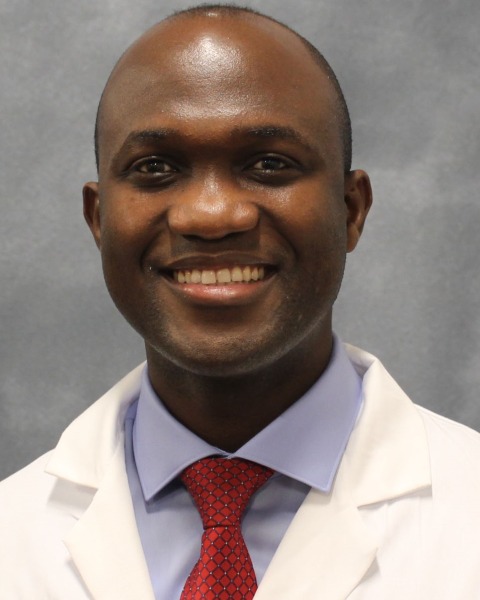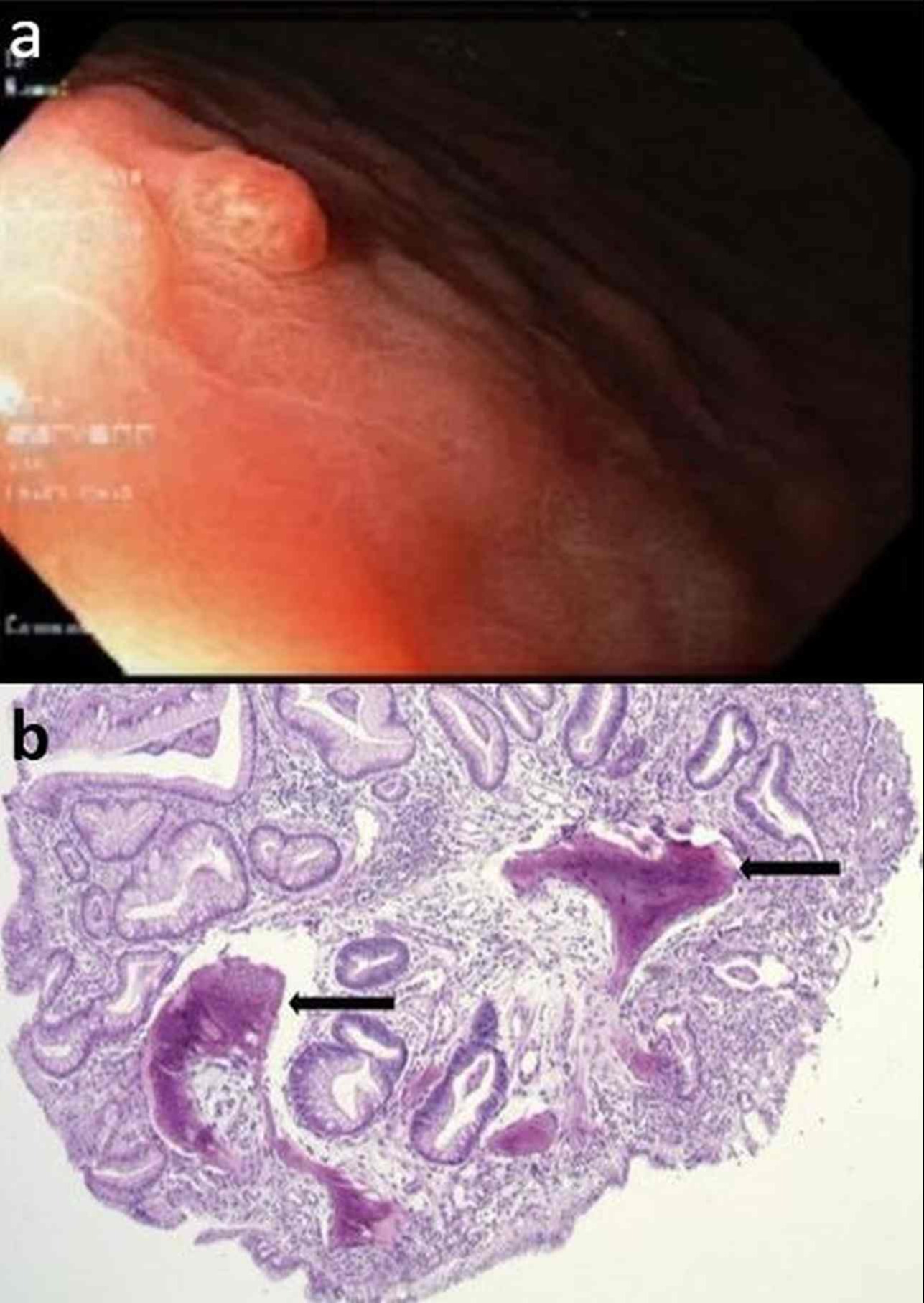Back
Poster Session B - Monday Morning
B0712 - Osseous Metaplasia in a Hyperplastic Gastric Polyp
Monday, October 24, 2022
10:00 AM – 12:00 PM ET
Location: Crown Ballroom

Kwabena O. Adu-Gyamfi, MBChB
Medical College of Georgia - Augusta University
Augusta, GA
Presenting Author(s)
Kwabena O. Adu-Gyamfi, MBChB1, Dariush Shahsavari, MD1, Praneeth Kudaravalli, MD2, Viveksandeep Chandrasekar, MBBS3, John Erikson L. Yap, MD3
1Medical College of Georgia - Augusta University, Augusta, GA; 2Augusta University Medical Center, Augusta, GA; 3Augusta University Medical College of Georiga, Augusta, GA
Introduction: Osseous metaplasia (OM) in the gastrointestinal tract is rare and typically associated with malignant gastrointestinal tract lesions. Benign gastric polyps containing OM are exceptionally rare with only six other cases reported to the best of our knowledge. A literature review also suggests a possible association with chronic liver disease. We describe the case of an elderly woman with cirrhosis who was found to have a solitary gastric polyp on outpatient esophagogastroduodenoscopy (EGD). This was resected and histopathology noted a hyperplastic polyp containing osseous metaplasia. The risk of future neoplastic transformation of osseous metaplasia is unknown.
Case Description/Methods: A 71-year-old Caucasian woman with history of Type 2 diabetes mellitus and compensated cirrhosis secondary to non-alcoholic steatohepatitis, with no gastrointestinal symptoms, underwent outpatient EGD to screen for esophageal varices. EGD revealed mild gastric antral erosions and a 2 mm sessile polyp in the proximal gastric body (Fig 1a) with no macroscopic neoplastic features. The polyp was resected with cold biopsy forceps and histological exam noted an inflammatory hyperplastic polyp with multiple foci of osteoblast-lined OM (Fig 1b arrows). Random gastric biopsies showed mild chronic gastritis negative for Helicobacter pylori. The rest of EGD was unremarkable and patient discharged home in stable condition to continue routine outpatient care for her cirrhosis.
Discussion: Osseous metaplasia in benign gastric polyps is a rare observation first reported by Ohtsuki et al in 1987 and has continued to intrigue clinicians as to its exact pathogenesis or relevance. Pathogenesis of OM in benign lesions is suspected to involve reactive osteoblast stimulation from chronic mucosal inflammation. Helicobacter Pylori infection has not been associated. A majority of the reported cases of OM in benign gastric polyps noted a form of chronic liver disease, including chronic viral hepatitis and cirrhosis. It is also unknown if OM represents a future risk for future neoplastic transformation. Continued reporting of similar cases is expected to help elucidate any clinical relevance of OM, any comorbid associations and possibly provide guidance on the optimal management or endoscopic surveillance for affected individuals.

Disclosures:
Kwabena O. Adu-Gyamfi, MBChB1, Dariush Shahsavari, MD1, Praneeth Kudaravalli, MD2, Viveksandeep Chandrasekar, MBBS3, John Erikson L. Yap, MD3. B0712 - Osseous Metaplasia in a Hyperplastic Gastric Polyp, ACG 2022 Annual Scientific Meeting Abstracts. Charlotte, NC: American College of Gastroenterology.
1Medical College of Georgia - Augusta University, Augusta, GA; 2Augusta University Medical Center, Augusta, GA; 3Augusta University Medical College of Georiga, Augusta, GA
Introduction: Osseous metaplasia (OM) in the gastrointestinal tract is rare and typically associated with malignant gastrointestinal tract lesions. Benign gastric polyps containing OM are exceptionally rare with only six other cases reported to the best of our knowledge. A literature review also suggests a possible association with chronic liver disease. We describe the case of an elderly woman with cirrhosis who was found to have a solitary gastric polyp on outpatient esophagogastroduodenoscopy (EGD). This was resected and histopathology noted a hyperplastic polyp containing osseous metaplasia. The risk of future neoplastic transformation of osseous metaplasia is unknown.
Case Description/Methods: A 71-year-old Caucasian woman with history of Type 2 diabetes mellitus and compensated cirrhosis secondary to non-alcoholic steatohepatitis, with no gastrointestinal symptoms, underwent outpatient EGD to screen for esophageal varices. EGD revealed mild gastric antral erosions and a 2 mm sessile polyp in the proximal gastric body (Fig 1a) with no macroscopic neoplastic features. The polyp was resected with cold biopsy forceps and histological exam noted an inflammatory hyperplastic polyp with multiple foci of osteoblast-lined OM (Fig 1b arrows). Random gastric biopsies showed mild chronic gastritis negative for Helicobacter pylori. The rest of EGD was unremarkable and patient discharged home in stable condition to continue routine outpatient care for her cirrhosis.
Discussion: Osseous metaplasia in benign gastric polyps is a rare observation first reported by Ohtsuki et al in 1987 and has continued to intrigue clinicians as to its exact pathogenesis or relevance. Pathogenesis of OM in benign lesions is suspected to involve reactive osteoblast stimulation from chronic mucosal inflammation. Helicobacter Pylori infection has not been associated. A majority of the reported cases of OM in benign gastric polyps noted a form of chronic liver disease, including chronic viral hepatitis and cirrhosis. It is also unknown if OM represents a future risk for future neoplastic transformation. Continued reporting of similar cases is expected to help elucidate any clinical relevance of OM, any comorbid associations and possibly provide guidance on the optimal management or endoscopic surveillance for affected individuals.

Figure: Fig 1a. Endoscopic image showing sessile gastric polyp (Fig 1a). Fig 1b. Histology slide (40x magnification) showing foveolar hyperplasia, background of abundant inflammation and multiple foci of osseous metaplasia (arrows).
Disclosures:
Kwabena Adu-Gyamfi indicated no relevant financial relationships.
Dariush Shahsavari indicated no relevant financial relationships.
Praneeth Kudaravalli indicated no relevant financial relationships.
Viveksandeep Chandrasekar indicated no relevant financial relationships.
John Erikson Yap indicated no relevant financial relationships.
Kwabena O. Adu-Gyamfi, MBChB1, Dariush Shahsavari, MD1, Praneeth Kudaravalli, MD2, Viveksandeep Chandrasekar, MBBS3, John Erikson L. Yap, MD3. B0712 - Osseous Metaplasia in a Hyperplastic Gastric Polyp, ACG 2022 Annual Scientific Meeting Abstracts. Charlotte, NC: American College of Gastroenterology.
